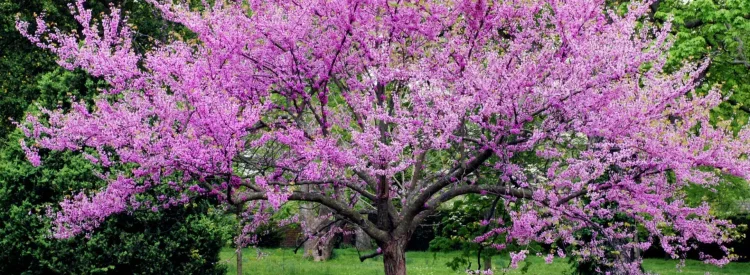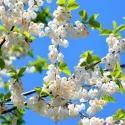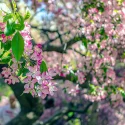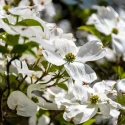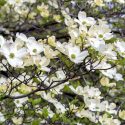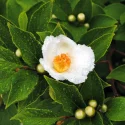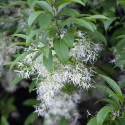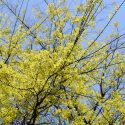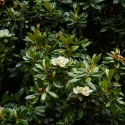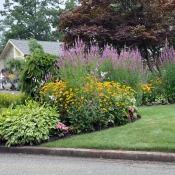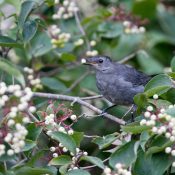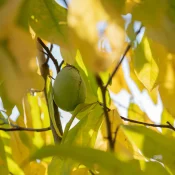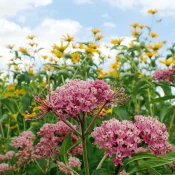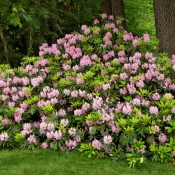Once you’ve seen a redbud tree flowering in early spring, you will not forget it. Redbuds cover their branches AND parts of their trunk with tiny pinkish-purple flowers. Redbud flowers emerge as early as February or March—sometimes beating daffodils. After the flowers, the tree fills its branches with heart-shaped leaves. Redbuds stay relatively small (30 feet), like full sun to part sun, and after the first year are happy with just rain. They are perfect no-fuss statement trees. Scroll on for planting tips.
Redbuds are gorgeous (even the White House agrees)
If you’re looking for a statement tree, consider native redbuds. These captivating trees not only offer striking views in all four seasons but also bring numerous benefits to your landscape. In this article, we’ll explore the beauty of the Redbud tree throughout the year, provide tips on planting and caring for it, discuss the importance of planting native species, and address any challenges you may encounter along the way.
What are the benefits of planting a redbud tree?
A native tree is a tree that has grown in its home area for thousands of years. Every type of weather it has lived through. It will thrive with only rain after being established.
Redbuds are trees native to North America. There are many reasons to plant native trees, including:
- Native trees are the preferred food and homes for pollinators and birds.
- Native trees are made to thrive in the weather and soil of their home area; after they are established, they are happy with rain.
- Native trees are gorgeous! They can make tulip flowers, have fringed flowers, or have banana-pineapple fruits.
New to native?
Before lawns and landscaping, native plants were here. They’ve fed birds, bees, and butterflies for thousands of years—and they’ll do the same in your yard. The best part? They’re easier to grow than you think.
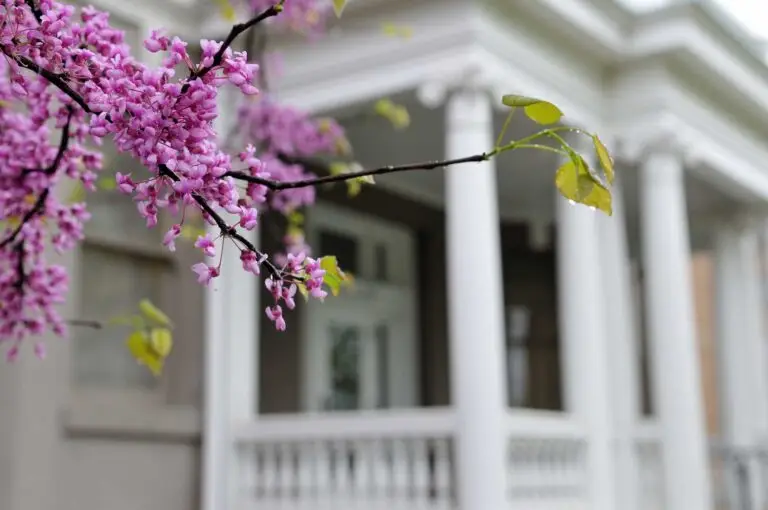
Redbuds have grown in North America for thousands of years and literally plant themselves. If you’re a beginner gardener feeling a bit overwhelmed, planting native plants makes gardening a breeze. Native trees are the easiest trees to plant and care for, especially compared to lawns.
There are two species of redbud: Eastern Redbud and Western Redbud
Almost everywhere in the continental US has a redbud tree available:
Eastern Redbud
In the eastern half of the US, you’ll find the Eastern Redbud (Cercis canadensis). The Eastern redbud species is native to a huge area—from New York south to Florida, and west to Texas and Michigan.
Western Redbud
In the western US, you’ll find the Western Redbud (Cercis occidentalis). It’s a little shorter than the Eastern—topping out around 15 feet. What it loses in height it makes up for in resilience. Western Redbuds can thrive in difficult climates, from mountains in Utah to the Sierras in California.
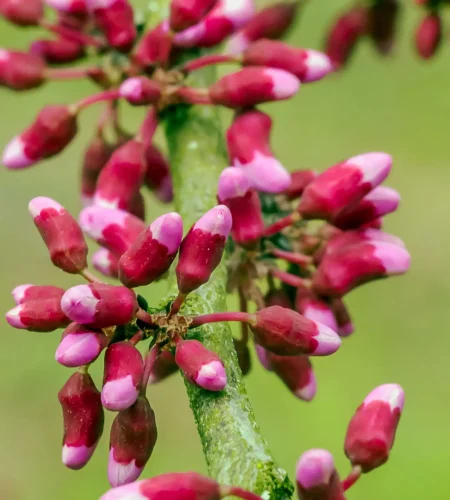
Why is it called redbud?
Redbud earns its common name from the color of the buds before bloom (which up close are a shade of red.) Common names are the names that generations before have given plants; this plant’s singular Latin name is Cercis canadensis or Cercis occidentalis (here’s a quick Latin/common name overview).
However, we think it needs another common name…
Redbuds should be called ‘Valentine trees’
We should call redbuds the ‘Valentine tree’ because each season they send out displays of affection and joy.
Redbuds throughout the seasons
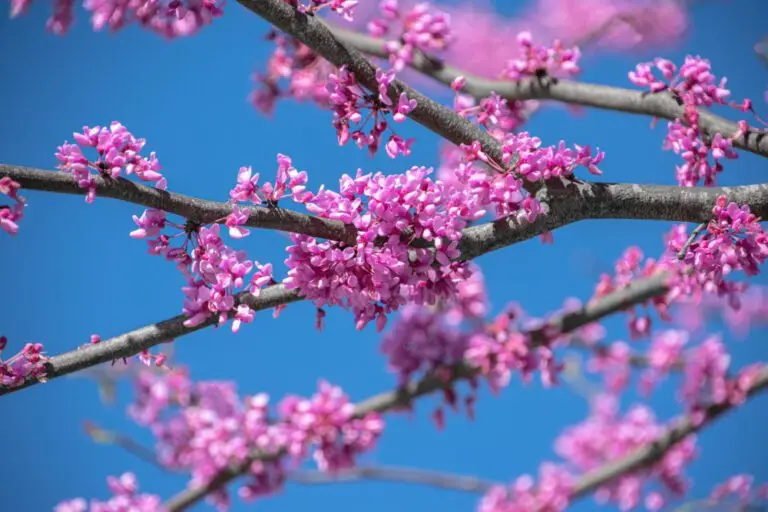
Spring
In the early spring, redbuds are among the first plants to flower. Their opulent flowering honestly puts cherry blossoms to shame. Not content to simply put flowers on their branches, they also cover parts of their trunk with tiny flowers.
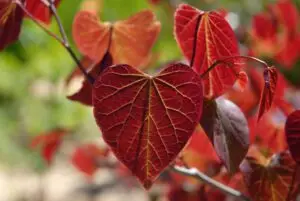
Summer
In the late spring and summer, they cover their branches with heart-shaped leaves. Yes, heart-shaped leaves!
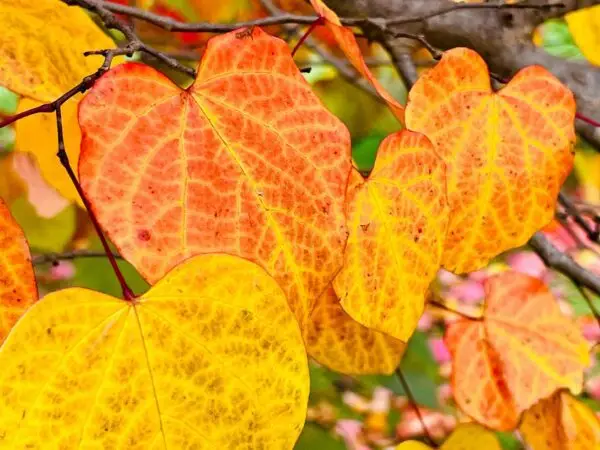
Fall
In the fall redbud leaves turn beautiful shades of yellow and orange. Beneath the leaves, you’ll find their pea-shaped seed pods dangling from branches.
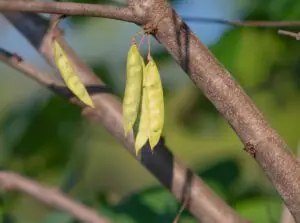
Winter
In the winter, their leaves drop to reveal their peapod-shaped seedpods, which look like hanging ornaments. (Redbuds are actually related to legumes like peapods.)
Redbud cultivars
A cultivar is a name given to a plant that has been selected or bred by humans for a certain characteristic. (Our cultivar overview goes into ways this has been done for centuries.) A true native plant is not a cultivar, since it has only changed due to nature and evolution—not human curation.
Redbud cultivars offer different leaf colors, weather resistance, and different heights. New ones are made every year because this is such an admired plant in landscaping.
There are 26+ redbud cultivars available
There are dozens of redbud cultivars out there—North Carolina Gardener’s Extension lists 26 redbud cultivars (along with some diseases/comments—it’s worth a read if you’re considering a cultivar redbud.) These cultivars include:
- Flame Thrower Redbud has leaves that change from yellow to green to red
- Golden Falls Redbud has branches that hang down, like a weeping willow
- Merlot Redbud has dark red, almost purple leaves
That said, we have an opinion on cultivars (if you’re interested)…
What is a cultivar?
Cultivar is short for CULTIvated VARieties. Cultivars are plants selected for traits like color, size, or disease resistance. Useful and sometimes stunning...but some lose the scent, shape, or timing wildlife depends on. Plant straight species when possible.
Looking for more seasonal information and cultivar examples? NC State Extension and Longwood Gardens have a helpful overview video on the Eastern Redbud along with cultivar images at the 3-minute mark. (Some of the language is a little academic, but the images help!)
Where to plant redbud trees
Redbuds are a perfect front yard tree
Redbuds are showstopper trees—put them in highly visible spots. They are worthy of making a statement on your front lawn. Give them a spot where you can admire them from inside your home as well as outside. (Also, check out the best native trees for front yards.)
Redbuds are also great beside taller trees
Redbuds also look great underneath taller trees. Redbuds are understory trees, which are shorter trees (the Eastern redbud usually gets not more than 30 feet tall) that tend to be found underneath larger trees in the forest. If you have an edge that could use some smaller trees, plant a few together alongside taller native trees like Oak, Tulip Poplar, and Cucumber Magnolias.
Where can you buy redbud trees?
Wherever you live, your best bet for finding a redbud that will thrive in your yard is visiting a local native plant nursery. They can answer any redbud questions and get you a tree that works well in your landscape.
Here are a few other ideas on where to find redbuds:
Where can I find seeds and plants?
Finding native plants can be challenging (we partly blame Marie Antoinette.) To make it easier, we’ve assembled four sourcing ideas.
300+ native nurseries make finding one a breeze
Explore 100+ native-friendly eCommerce sites
Every state and province has a native plant society; find yours
Online Communities
Local Facebook groups are a great plant source
How to plant a redbud tree
Native trees like the redbud literally plant themselves, so feel comfortable planting one yourself!
- Find a sapling: Visit a local nursery to find a redbud sapling; to date, it is rare to find these trees at big-box retailers.
- Location: Find a spot with well-drained soil with full sun to part sun. The redbud is a resilient tree that can adapt to various conditions.
- Planting: Dig a hole twice as wide as the tree’s roots, gently place your redbud tree, and backfill the hole with soil and some compost (you can buy a bag from any plant nursery). No need to worry about precise measurements, just ensure it’s level with the ground.
- Watering: Give your new redbud tree a good drink after planting and water it regularly during the first year to help it establish strong roots.
- Pruning: Keep it simple—prune only if needed to remove dead branches or shape the tree. Otherwise, let nature do its thing.
What to plant with redbud trees
There are so many showstopper native plants to plant alongside redbuds. Some favorites for the south, northeast, or mid-Atlantic include Rhododendrons, Mountain Laurel, Pawpaw trees, and Golden Alexander.
Let’s all plant a redbud—America’s ‘Valentine Tree’
Redbuds are a great tree to put in a highly visible spot and enjoy year-round. (Check out our Best Native Trees for Front Yards if that’s your landscaping goal!) They change throughout the year in surprising ways, from tiny flowers to heart-shaped leaves. Plant one (or a few!) today and enjoy the love. Happy planting!
Sources
- Harstad, Carolyn. Go Native! Gardening with Native Plants and Wildflowers in the Lower Midwest. (1999).
- Johnson, Lorraine and Colla, Sheila. A Northern Gardener’s Guide to Native Plant and Pollinators; Creating Habitat in the Northeast, Great Lakes, and Upper Midwest. (2023), 175.
- Nelson, Gil. Best Native Plants for Southern Gardens: A Handbook for Gardeners, Homeowners, and Professionals, (2010).
What if your feed was actually good for your mental health?
Give your algorithm a breath of fresh air and follow us.
